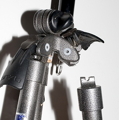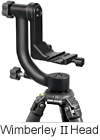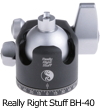Under Construction 

Contents: Lenses |
Teleconverter (TC) or Tele Extender |
Tripods | Heads | Some NJ Photographers
Wildlife photography whether it be big game in Africa or photographing birds in your back yard generally requires special equipment.
What you need:
A good lens - ≥400 mm $1,000-$6,000+
A good tripod and head $500-$1,200+
See tripods below
Lenses:
The cost of going beyond 400mm (and retaining good image quality) is high, but a longer-than-400mm lens is usually desired for wildlife photography.
Note: APS-C DSLRs have a 1.6x narrower angle of view, making a 400mm lens frame like a 640mm lens.

An option to save cost and size, making it easier to manipulate and transport is to use a teleconverter (TC) (see below), which goes between the lens and camera body. The disadvantage is that you will loose 1-2 f stops and could loose autofocus at smaller apertures.
Some options from the list below.

With an APS-C sensor you will get the equivalent of 448 and 480mm
At Golden Gate Audubon Society they say,
"I think for starting out, the 100-400 zoom lens is very versatile and gives some quite good images, especially when paired with the 7D body. That's all you need - that, and lots of practice!
If the objective is birds in flight, I will also take along a 400mm f4 lens to hand hold. Note that Nikon also offers similar equipment of similar quality. But you have to choose one manufacturer."
A 200-300mm lens is OK for backyard bird photography.
Teleconverter (TC) or Tele Extender
A teleconverter goes between the lens and camera body and multiplies the focal length.
Common factors are 1.4x, 1.7x and 2x. Unfortunately they reduce the aperture; 1 stop for a 1.4x and 2 stops for a 2x. An f/4 lens becomes an f/5.6 lens with a 1.4x mounted.
If the resulting aperture is smaller (higher number) than f/5.6 autofocus will not work on consumer cameras.
A 400mm f/5.6 lens fitted with a 1.4x TC will behave like a 560mm f/8 lens.
1.4x $225-$500
See Tele Converter in photography
Some lenses which were recommended for Cannon cameras. Nikon has similar choices:
| Type | price | len | diam | wt
lbs | Notes/Reviews*
B&H - Amazon |
| Canon 1.4x EF Extender III (Teleconverter) | $449 | 1.1" | 2.8" | | 4.7 (228) |
Tamron 1.4x SP AF Pro Teleconverter
For lens with aperture off/2.8 or larger | $224 | 0.7" | 2.7" | 0.3 | 4.6 (19) |
Kenko Teleplus PRO 300 DGX 1.4x AF TC | $194 | 1.1" | | 0.3 | 4.4 (49) |
| Canon EF 70-300mm f/4-5.6 IS USM Lens | $650 | 5.6" | 3.0" | 1.4 | 4.5 (799) |
| Canon EF 200mm f/2.8L II USM Lens | $820 | 5.4" | 3.3" | 1.7 | 4.9 (136) |
| Canon EF 300mm f/4L IS USM Lens | $1,449 | 8.7" | 3.5" | 2.6 | Older IS |
| Canon EF 100-400mm f/4.5-5.6L IS USM Lens | $1,700 | 7.4" | 3.6" | 3.0 | 4.7 (1,028) |
| Canon Telephoto EF 400mm f/4.0 DO IS USM Autofocus | $6,000 | 9.1" | 5.0" | 4.3 | 4.7 (31) |
| Canon EF 600mm f/4L IS II USM Lens | $12,800 | 17.6" | 6.6" | 8.6 | 4.8 (13) |
| Sigma 150-500mm f/5-6.3 DG OS HSM APO | $969 | 9.9" | 3.7" | 4.2 | 4.4 (145) - 4.5 (213) |
Canon EF 70-200mm f/2.8L IS II USM | $2,499 | 7.8" | 3.5" | 3.3 | 4.9 (2,142) |
Tamron SP 70-200 f/2.8 | $1,499 | 7.4" | 3.4" | | 4.8 (24) 4.2 (217) |
Sigma 70-200mm f/2.8 EX DG OS HSM | $1,249 | " | " | | 4.7 (100) |
Sigma 18-250 f/3.5-6.3 | $349 | 3.5" | 2.9" | | CR, 4.3 (95) |
Canon EF-S 18-200 f/3.5-5.6 IS | $699 | 4.0" | 3.1" | | CR, 4.6 (419) |
CR - Interchangeable & SLR lenses Ratings - ConsumerReports Nov. 2013
* Reviews 4.5 (799) - 799 reviewers with average of 4.5 out of 5
See:
Canon DSLR Tips: What's the best telephoto zoom? | PhotoPlusMag.com
Lens recommendations from Phil Witt.
Terminology - What do the lens parameter abbreviations mean? - Photography Stack Exchange
Glossary of terms
Digiscoping - Spotting scope with digital camera adapter.
If you're a birder you probably already own a $1,500 spotting scope by Swarovski, Nikon or Zeiss. If you do, you have a basis for getting good shots with an adaptor.
These are about $150
See All Digital Camera Adapters Sorted by Best Selling from Eagle Optics,
Nikon | Sport Optics | Digiscoping System,
Zeiss SLR Camera Adapter B&H Photo
 Tripods & heads:
Tripods & heads:
The high magnification amplifies every vibration so a tripod is important. They also reduce muscular fatigue during long sessions with a heavy lens.
Image to the right of a cheap aluminum tripod which broke with a $8,000 camera.
For handheld photos with a 300 mm lens you need to use at least 1/300 of a second for sharp results. Image Stabilization (IS/VR) will allow you to gain 2 stops. I.e. shoot at 1/75 with a 300 mm lens.
But in low light or for longer lenses you will need a tripod.
A good tripod for heavy lenses will cost from $300-$750
A monopod may work in some cases to at least reduce muscle fatigue.
Carbon fiber tripods are recommended over aluminum for lower weight and the greater absorption of vibrations.
Always make sure that the tripod you want to buy can support at least 1.5 times more than the total weight of your camera and your heaviest lens.
A Canon EOS 70D DSLR is 1.7 lb (body only), so with a 4.2 lb lens you would want a tripod rated at 8.8 lbs.
* A carry-on suitcase is 20" long
1. Comp = Composite Carbon Fiber
See Tripods at Digital Bird Photography
and An Overview of the Best Tripods and Heads - The Canadian Nature Photorapher -
Some of my tripods, my favorite 1) includes a Gitzo GT3530LS Systematic Carbon Fiber tripod ($775) with a Really right stuff ballhead ($355) and Optech insulated leg covers, total cost over $1000. 2) Milano M1-CF4SQR tripod with Milano B-2 Ball head total cost about $400 3) I use an Ergo rest with Acratech ballhead for shooting from my car window, the acratech ballhead also works well on
Midrange prices for an aluminium or even a carbon fiber tripods range between $200 to $400 e.g. the Milano carbon fiber from London drugs or a wide range of Manfrotto tripods. The high range usually includes tripods over $500 to about $1000 and that includes most carbon fiber tripods from Manfrotto, Feisol and the most expensive photographic tripods are from Gitzo.
See Tripods & Telephotos - How To Lessons | Manfrotto
Heads:
Any bird actively foraging in a tree or on the ground will require constant tracking, and the particular head you choose for your tripod can make that task of tracking the bird either manageable or onerous.

A gimbal head works like a see-saw: it maintains a fine balance on the lens, so that very moderate forces applied to one end (the camera end) are able to precisely control movement of the other end (the objective lens end).
A Wimberly head ($250-$600) is the most popular, but some say the Induro.
Best tripod for a heavy telephoto lens? - PentaxForums.com says,
 "I would normally get a pan head, but I am mostly going to be working outdoors on uneven ground, so I don't want to adjust horiz/vert pan AND tilt the whole time, as it would take too much time trying to photograph birds and wildlife. I think a ballhead is better for my needs (but, sadly, more expensvie.)"
"I would normally get a pan head, but I am mostly going to be working outdoors on uneven ground, so I don't want to adjust horiz/vert pan AND tilt the whole time, as it would take too much time trying to photograph birds and wildlife. I think a ballhead is better for my needs (but, sadly, more expensvie.)"
Ball heads are not good for large lenses. A ball head effectively allows the lens to tilt in any direction, and this makes it very difficult to keep a large, heavy lens stable.
However at The Canadian Nature Photorapher Dr. Robert Berdan shows a friend using a Really right stuff (RRS) ball head ($355) with a 600 mm F/4 lens.
See Heads at Digital Bird Photography
and Tripod & Monopod Heads
Why A Ballhead? | Really Right Stuff-Why
1. The Wimberly Sidekick will safely carry the weight of a very big lens provided it is mated with a ball head that will hold the weight of the lens.
Generally, 400 f/5.6 and 300 f/4 fixed or zoom lenses with medium-weight camera bodies work well. Heavier camera bodies on theses lenses can be problematic (even more so on 70-200 f/2.8 and smaller lenses).
Tripod Heads sorted by rating | B&H Photo Video
Roman Kurywczak reviews: Induro GHB2 gimbal head.
Ball Heads | Buy, Compare & Review | Adorama
Tools of the Trade at David Desrochers Photography : About
David shoots with Canon EOS 5D Mark III and EOS 7D Mark II digital bodies. His lenses include the Canon 100-400 MM and 500 MM telephotos, the Sigma 150-600 MM Contemporary, a 14 MM wide angle, 24-105 MM standard zoom, and a 180 MM Macro.
Camera supports include the Grand Induro Series EP Carbon 8X, Model CT304 and a Manfrotto 055CXPro3 carbon fiber tripods. A GHB2 Gimbal Head is used to support the 500 MM lens and the Really Right Stuff BH-55 Full Size Ball Head with the PCL-1 Panning Clamp is used for his landscape and macro work. Both camera bodies utilize Kirk Photo L-Brackets. David travels with the Think Tank Airport International roller page and the MindShift Gear rotation180° Panorama 22L backpack.
He also recommends The Photographer's Ephemeris® (TPE), a tool to help you plan outdoor photography in natural light, with apps for iOS and Android.
David Desrochers teaches Audubon Nature Photography Workshops with Phill Witt and is a popular speaker on Nature Photography.
Photographers who have given me advice.
Phil Witt (www.flickr.com/people/philwitt/) is an avid bird photographer who travels the world with a suitcase (or two) full of photography equipment. Phil Witt and Dave DesRochers run a series of Digital Photography Workshops at the NJ Audubon center in Bernardsville, NJ.
See his "How to reach ≥ 400 mm for photographing birds".
Tom McBride www.flickr.com/photos/tomm_dogg
Gary Westerhoff Westerhoff Nature Photography (www.westerhoffnaturephotography.com)
Portrait:
Thomas F. Marshall www.imagesbyTFM.com
Arik Gorban www.agphotoworks.com
Links:
The Photographer's Ephemeris® (TPE) is a tool to help you plan outdoor photography in natural light, with apps for iOS and Android.
DSLR Reviews on the products page.
Glossary of terms
Canon Wildlife Lens (the-digital-picture.com)
Nikon Zoom Lens Reviews (the-digital-picture.com)
How to Photograph Birds | Ken Rockwell
All About Birds : Bird Photography | birds.cornell.edu
Secrets of Digital Bird Photography | DigitalBirdPhotography.com
Bird Photography | NaturePhotographers.net
Learning to be a bird photographer | Golden Gate Audubon Society
Return to Hobbies
last updated 1 Mar 2017
| 

 Tripods & heads:
Tripods & heads: